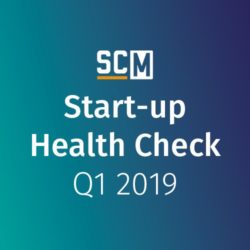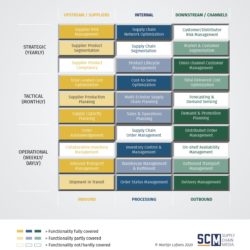Optimism among start-ups gives way to realism

Over the past six years, venture capitalists have ‘discovered’ the supply chain and have invested billions in start-ups, especially in the USA and China. However, many start-ups now find themselves in a crucial phase, especially now that the coronavirus pandemic means that venture capitalists have become a lot less generous with their money. Supply chain start-ups are significantly less optimistic than a year ago, particularly in Europe.
By Marcel te Lindert
A decade ago, supply chain was clearly not on the venture capitalist radar. The total investment in supply chain start-ups amounted to no more than 100 million dollars – a pittance compared to the total funds that venture capitalists have at their disposal. Then about six years ago there was a sudden turnaround. Over the space of five years, investment in supply chain start-ups grew by a factor of 100 and reached the mind-blowing amount of 10 billion dollars in 2018. “Needless to say, we’re seeing investments decreasing this year as a result of COVID-19, but by nowhere near as much as in other sectors,” says Ludwig Hausmann, a partner specialized in travel, logistics and transport infrastructure at McKinsey & Company.
McKinsey & Company has conducted extensive research into supply chain start-ups all over the world and analysed around 200 of the largest start-ups and their investors, good for 30 billion dollars between them. Hausmann discussed the insights together with his colleague Tobias Wölfel and Martijn Lofvers from Supply Chain Media in a webinar. “Supply chain innovation has always been important. It’s also necessary in order to reduce costs and facilitate globalization, which is why we studied start-ups in this sector,” said Hausmann.
Last mile attracts 10.5 billion dollars
The turnaround six years ago is largely due to the growing importance of e-commerce. That’s also why venture capitalists are largely investing their money – around 10.5 billion dollars in total – in start-ups with new last-mile solutions. “Initially, investors were particularly interested in solutions with a major impact on consumers. But that amount of 10.5 billion dollars doesn’t even include the meal-delivery platforms,” stated Hausmann.
The focus on the last mile is perhaps surprising because, in terms of market size, this branch of logistics accounts for just a fraction of the total transport market. “But last mile is a growth market, and venture capitalists tend to look at growth rather than the total market size. The general opinion is that an investment in this growth market offers a greater chance of a good return on investment than the traditional transport market.”
Road freight marketplaces
In recent years, venture capitalists have become increasingly interested in marketplaces for road freight, which have received a total of 7.2 billion dollars in investment. Hausmann: “This is a market with traditional, inefficient business models. It offers a lot of potential but it also has a lot of start-ups, and by no means all of them will survive. In particular, there won’t be much room for price comparison websites because they offer limited added value. The supply chain platforms with the most added value will attract the most capital – they are the platforms that can succeed in building a loyal customer base.”
Start-ups don’t always need to focus on a new business model, however. New logistics service providers are enjoying significant success, especially in countries like India. “These are markets where today’s major logistics service providers still lack comprehensive coverage, so there’s room for newcomers who copy successful business models from other markets,” said Wölfel, a specialist on the transport and logistics industry at McKinsey & Company.
Just 5% for Europe
Initially, start-ups in the USA received the most venture capital (58%), but that had dropped sharply to 34% by 2019. China has now taken the lead; it attracts 39% of venture capital, and six out of the ten start-ups with the most funding are Chinese. The rest of Asia accounts for 18% of the venture capital, with half of that going to India.
As for Europe, it receives a paltry 5% according to Wölfel: “Europe receives less venture capital than the USA and China in other sectors too, but the supply chain sector is the lowest by far – and yet the European economy makes up 25% of the global economy, and Europe is particularly strong in logistics. In fact, European logistics service providers account for a significant share – 46% – of the turnover in the global logistics market.”
The experts from McKinsey had an explanation for that: venture capitalists see Europe as a risk-averse continent with a high regulatory burden. “Moreover, despite the internal market in the EU, Europe remains a fragmented continent with different countries, cultures and languages. As a result, start-ups have limited possibilities to scale up,” explained Wölfel.
From optimism to realism
Supply Chain Media’s own overview of European supply chain start-ups confirms that the European market is fragmented. Each country has its own start-ups offering warehousing capacity or facilitating tenders for logistics services. Segments such as last-mile delivery, freight marketplaces and supply chain visibility are even becoming overcrowded with start-ups. “What’s particularly striking is the emergence of start-ups with blockchain solutions. That’s where much of the venture capital in Europe has gone in the past year,” said Martijn Lofvers, chief trendwatcher at Supply Chain Media.
Every six months, Supply Chain Media conducts a brief survey among start-ups by asking them to answer ten questions. The most recent responses indicate that many of them are struggling and that the initial optimism has given way to realism in many cases. For example, it is proving to be more difficult than hoped to start pilots with potential customers and convert them into business deals. Lofvers: “When talking to start-ups, we notice that they all regard themselves as pretty unique, but our overview shows that many start-ups offer more or less similar solutions. A bit of realism wouldn’t go amiss in that respect!”
Taking advantage of the pandemic
For many start-ups, the pandemic has certainly not made things easier – far from it. Compared to last year, venture capitalists have reduced their investment in start-ups by half, which reduces the chance of success. “Nevertheless, some start-ups are benefiting from the crisis. For example, newcomers in fulfilment and parcel shipping are benefiting from the unexpected increase in e-commerce. Venture capitalists are also showing more interest in start-ups offering supply chain visibility. They have proven their worth during the pandemic,” said Hausmann.
So looking to the future, which questions do logistics companies need to answer? Investors should continue to look for supply chain inefficiencies that are prone to disruption. For start-ups, the main challenge is still how to achieve scalability and profitability. “Existing logistics service providers need to devise a digital strategy so they don’t miss the boat. Should they acquire start-ups, collaborate with them or set up their own?” he continued. Hausmann concluded by offering some useful advice: “You can’t judge innovations until you’ve tested them. That holds true for investors as well as shippers and logistics service providers. So start working with start-ups and see what you can learn from them.”










